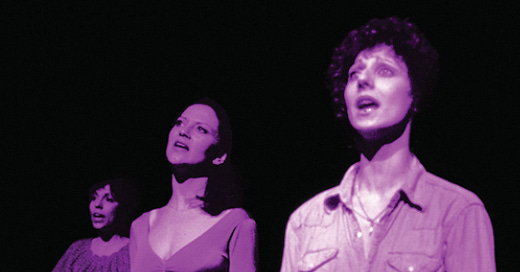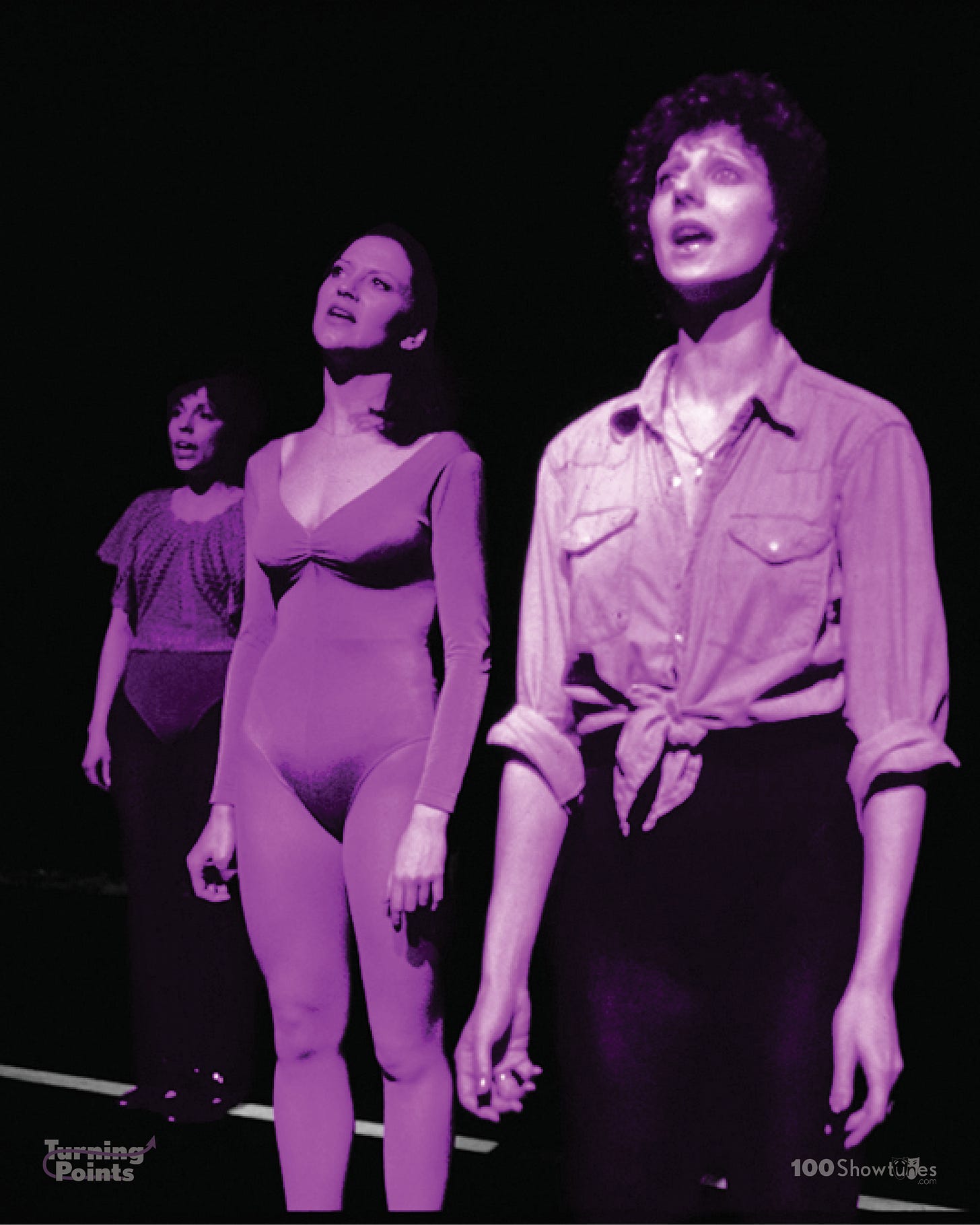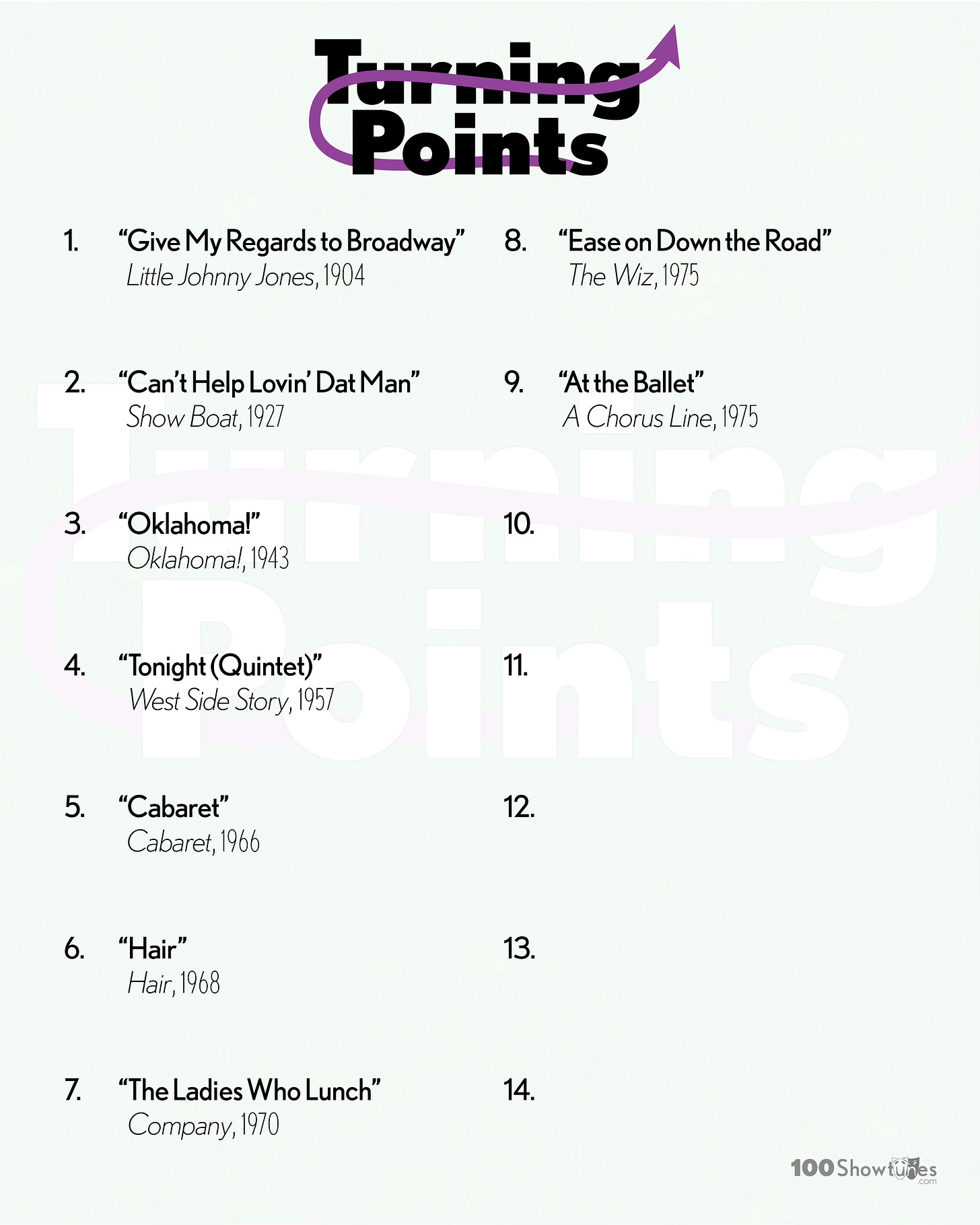No. 9. “At the Ballet”
A CHORUS LINE (1975). By Marvin Hamlisch (music), Edward Kleban (lyrics), James Kirkwood and Nicholas Dante (book). Conceived by Michael Bennett.
Spring 1975. You managed to snag a seat downtown to see the debut production of A Chorus Line at The New York Shakespeare Festival (earning you bragging rights for decades, though you don’t know that yet). You walk into what looks like an empty theater with a line of mirrors in the back. The lights go down and a piano plays an opening “da-da da-da da da” as a lone voice shouts “Again!” The lights come up on a group of dancers learning and trying out choreography in varying groups as individual dancers sing about how much they need a job. This whirlwind sequence continues with dancers getting cut until the top 16 step forward and form a line with their headshots in front of their face. The mirrors turn into a black wall, and the stage feels less like a literal theater and more like the “limbo” you saw years earlier in Cabaret. A director (Zach, who mostly appears as a disembodied voice from the back of the theater), asks the dancers to tell him where they’re from and why they want to dance. (One of the dancers is Cassie, Zach’s ex who left New York for Hollywood only to come back desperate for a job, even one in the chorus.) When the first dancer shares a charming song about following his sister’s footsteps into dance, you wonder if you’re going to have to sit through the pattern of introductory-anecdote-then-song fifteen more times. But soon Sheila, the resident smart-ass, begins a performative story about her childhood. When Zach demands less showmanship and more emotional authenticity, her story becomes “At the Ballet,” a song that reveals how dance became an escape from an unhappy home. As Sheila sings, the rest of the company disappears into darkness behind her. Soon two others (Bebe and Maggie) step forward with their own verses, and similar stories. When Maggie hits a climactic high note as the music swells, a ballet scene appears briefly in the background before disappearing into the void. As the song ends, the lights come back up and the trio rejoins the line. You realize this seemingly simple concept will be less literal and more sophisticated (dramatically and technically) than you first thought.
A Chorus Line was an unlikely phenomenon. It began when director/choreographer Michael Bennett led a series of conversations between dancers from Broadway choruses in which they shared stories about their childhoods, their dreams, and their love of dance. Bennett, and many of these dancers, developed these conversations into a concept musical that seamlessly integrated music, dancing, and dialogue to explore this community united by a shared passion. As it draws the audience in emotionally, the audience seems themselves in the humanity on stage1. With so many stories to share, ideas to explore, and ways to tell them, Bennett and his collaborators needed a unique process to distill it all into an integrated piece. They needed space and permission to try out ideas and build sequences from scratch, with collaboration from the cast and designers. This was the birth of the Workshop process—rehearsal periods that don’t culminate in public performances. It ironically led to a show that would have more public performances than any in Broadway history at that point—a 15 year run. Now nearly every show that opens on Broadway has at least one workshop as part of its development (even if they aren’t as loose and experimental as Bennett envisioned).
Recommended Recording: ”At the Ballet,” A Chorus Line (1975 Original Broadway Cast)
Most of the original cast participated in the initial story-sharing sessions that led to this show (even if not everyone is necessarily telling their personal story). The OBCR is the 8th most popular cast recording ever released and beautifully captures the performances and Marvin Hamlisch’s exciting score. Kelly Bishop (matriarch Emily Gilmore on The Gilmore Girls) is the sardonic Sheila.
Alternate Performances
A Chorus Line has received 11 cast recordings. Many didn’t think the show would even work without the original cast—and they’ve had to spend the past 50 years eating crow as thousands of people have played these roles. “At the Ballet” is a popular choice anytime a concert calls for three soloists, one of whom can hold a big note for a really long time. Barbra Streisand sings a version with Anne Hathaway and Daisy Ridley on her 2016 album Encore: Movie Partners Sing Broadway. Julie Andrews did a one-woman version on a 1978 TV special that makes a really strong case for never doing a one-person version of “At the Ballet.”
1985 Film: Michael Bennett didn’t want to have anything to do with a movie version when his concept—a movie about auditions for the movie of A Chorus Line—was rejected. Studios—no doubt encouraged by the success of movies like Fame and Flashdance that capitalized on the ACLaesthetic—wanted a movie anyway. But no one had an idea as to how to make a good movie out of the inherently theatrical material. Richard “Welcome…to Jurassic Park!” Attenborough directed what feels like the product of a team that had to make a movie of A Chorus Line, but didn’t particularly want or need to. It’s a completely literal and surface-level production. You still get backstories from a likable cast, but it’s like watching a season of So You Think You Can Dance in two hours. Padded scenes break up most of the major musical sequences, killing the pacing without actually adding anything meaningful. Michael Douglas plays Zach, and you never believe he has ever seen a musical much less choreographed one. “At the Ballet” is somehow less cinematic than it was on stage, with literally no ballet of any kind. The one-woman Julie Andrews version has better staging!
2006 Broadway Revival: The most interesting thing about the 2006 revival of A Chorus Line (directed by original co-choreographer Bob Avian with original cast member Baayork Lee re-creating the original choreography) is the documentary Every Little Step, about the production’s casting process. It features a fun bit about Maggie’s long, belted note in “At the Ballet” and has great fun arc about who should play Sheila.
2019 Spanish Cast: Antonio Banderas directed this production and starred as Zach. A Chorus Line is one a several musicals he recently produced/directed in Spain that has received a beautiful, fully orchestrated, cast recording.
Is it Covered by The Rat Pack, Audra McDonald, or Glee?
Audra McDonald, Megan Hilty and Kelli O’Hara sang “At the Ballet” in a 2013 Live from Lincoln Center tribute to Marvin Hamlisch. Audra sings Sheila’s part, and Kelli gets the Maggie monologue and note. It is staged better than the movie version. Audra was also in a Fresno Dinner Theater production of A Chorus Line as a teenager.
Glee features “At the Ballet” in season 4 episode 20 (“Lights Out”). Kurt (Chris Colfer) brings Santana (Naya Rivera) and Rachel (Lea Michelle) to a NYC Ballet Gala as part of his internship at Vogue. Santana remembers attending ballet classes as a child, leading to a performance by Santa, Rachel, Kurt, and Isabelle (Kurt’s boss, played by Sarah Jessica Parker). It is staged significantly better than the movie version. Other A Chorus Line songs to appear on Glee: “One” (in a deleted scene from the pilot), “Hello Twelve, Hello Thirteen, Hello Love” (season 1, episode 14), “What I Did for Love” (season 2, episode 1), and “Sing” (season 2, episode 4).
In the Wings
While you wait for song 10 to drop next week, look up “Mario Lopez A Chorus Line sleeves controversy” the learn about one of Broadway’s pettiest feuds (and the second most interesting thing about the 2006 Broadway revival).
This framework—a bunch of folks get together and sell themselves in order to win something—has proven reliable and adaptable, leading to shows like Cats, Six, Altar Boyz, and Ride the Cyclone, to name a few.







EC graduate (1967), Crissy Wilzak, played Vicki in the original cast of A Chorus Line.